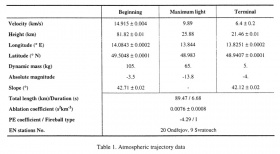(Unless otherwise stated, the copyright of the materials included belong to Jan Woreczko & Wadi.)
Vimperk
Z Wiki.Meteoritica.pl
| Linia 5: | Linia 5: | ||
O godzinie 22:51:56 (UT) 31 sierpnia 2000 roku nad Czechami obserwowano jasny bolid (o jasności dochodzącej do -13,8<sup>m</sup>). Przelot bolidu został zarejestrowany przez stacje bolidowe European Fireball Network (EN). Pozwoliło to wyliczyć orbitę meteoroidu i dane dotyczące ewentualnego spadku. | O godzinie 22:51:56 (UT) 31 sierpnia 2000 roku nad Czechami obserwowano jasny bolid (o jasności dochodzącej do -13,8<sup>m</sup>). Przelot bolidu został zarejestrowany przez stacje bolidowe European Fireball Network (EN). Pozwoliło to wyliczyć orbitę meteoroidu i dane dotyczące ewentualnego spadku. | ||
| - | Meteoroid wszedł w atmosferę z bardzo małą prędkością 14,92 km/s i zapłonął na wysokości 81,82 km. Zgasł na wysokości tylko 21,46 km przy prędkości 6,4 km/s. Był to bolid [[Bolidy (typy)|typu I]]. Według obserwatorów z EN początkowa masa meteoriodu wynosiła ~105 kg, a wyniki modelowania przelotu dopuszczają spadek fragmentu(ów) o wadze nawet 5 kg. | + | Meteoroid wszedł w atmosferę z bardzo małą prędkością 14,92 km/s i zapłonął na wysokości 81,82 km. Zgasł na wysokości tylko 21,46 km przy prędkości 6,4 km/s. Był to bolid [[Bolidy (typy)|typu I]]. Obliczone parametry orbity meteoroidu wskazują, że należał on do grupy planetoid Aten. Według obserwatorów z EN początkowa masa meteoriodu wynosiła ~105 kg, a wyniki modelowania przelotu dopuszczają spadek fragmentu(ów) o wadze nawet 5 kg. |
=== Lokalizacja === | === Lokalizacja === | ||
| Linia 22: | Linia 22: | ||
</div> | </div> | ||
| - | Według obserwatorów z EN: ''...probable impact point for meteorite with terminal mass of 5 kg are: 48.8694 deg N, = 13.8082 deg E. The predicted impact area has a shape of rectangle about 2 km long and 500 m wide. Unfortunately all this impact area lies in the hilly, marshy and heavily forested Sumava Mountains region. Therefore the systematic search for meteorites was very difficult. Nevertheless about 60% of the impact area was thoroughly searched (and most of the other part less thoroughly) in September and October 2000. No meteorites have been recovered yet''.<ref>Spurný et al. (2001)</ref> | + | Według obserwatorów z EN: ''(...)'''probable impact point for meteorite with terminal mass of 5 kg are: 48.8694 deg N, = 13.8082 deg E'''. The predicted impact area has a shape of rectangle about 2 km long and 500 m wide. Unfortunately all this impact area lies in the hilly, marshy and heavily forested Sumava Mountains region. Therefore the systematic search for meteorites was very difficult. Nevertheless about 60% of the impact area was thoroughly searched (and most of the other part less thoroughly) in September and October 2000. No meteorites have been recovered yet''.<ref>Spurný et al. (2001)</ref> |
Jak widać szanse na spadek były duże i podjęto systematyczne poszukiwania. Jak na razie meteorytów nie znaleziono. | Jak widać szanse na spadek były duże i podjęto systematyczne poszukiwania. Jak na razie meteorytów nie znaleziono. | ||
| Linia 39: | Linia 39: | ||
== Linki zewnętrzne == | == Linki zewnętrzne == | ||
| + | * Wikipedia - [http://pl.wikipedia.org/wiki/Grupa_Atena Grupa Atena] | ||
* [http://www.woreczko.pl/meteorites/features/glossary-FireballNetwork.htm Sieci bolidowe (''fireball network'')] | * [http://www.woreczko.pl/meteorites/features/glossary-FireballNetwork.htm Sieci bolidowe (''fireball network'')] | ||
Wersja z 10:17, 15 lut 2012
Bolid z 31 sierpnia 2000 roku - EN310800 „Vimperk”.
O godzinie 22:51:56 (UT) 31 sierpnia 2000 roku nad Czechami obserwowano jasny bolid (o jasności dochodzącej do -13,8m). Przelot bolidu został zarejestrowany przez stacje bolidowe European Fireball Network (EN). Pozwoliło to wyliczyć orbitę meteoroidu i dane dotyczące ewentualnego spadku.
Meteoroid wszedł w atmosferę z bardzo małą prędkością 14,92 km/s i zapłonął na wysokości 81,82 km. Zgasł na wysokości tylko 21,46 km przy prędkości 6,4 km/s. Był to bolid typu I. Obliczone parametry orbity meteoroidu wskazują, że należał on do grupy planetoid Aten. Według obserwatorów z EN początkowa masa meteoriodu wynosiła ~105 kg, a wyniki modelowania przelotu dopuszczają spadek fragmentu(ów) o wadze nawet 5 kg.
Lokalizacja
prawdopodobne miejsce spadku fragmentu(ów)
Trasa bolidu EN310800
Według obserwatorów z EN: (...)probable impact point for meteorite with terminal mass of 5 kg are: 48.8694 deg N, = 13.8082 deg E. The predicted impact area has a shape of rectangle about 2 km long and 500 m wide. Unfortunately all this impact area lies in the hilly, marshy and heavily forested Sumava Mountains region. Therefore the systematic search for meteorites was very difficult. Nevertheless about 60% of the impact area was thoroughly searched (and most of the other part less thoroughly) in September and October 2000. No meteorites have been recovered yet.[1]
Jak widać szanse na spadek były duże i podjęto systematyczne poszukiwania. Jak na razie meteorytów nie znaleziono.
Bibliografia
- +Clark David L., (2010), Searching for Fireball Pre-detections in Sky Surveys. The University of Western Ontario. Plik PDF
- +Spurný Pavel, Borovička Jiří, (2001), EN310800 Vimperk fireball: probable mereorite fall of an Aten type meteoroid. Proceedings of the Meteoroids 2001 Conference, 6-10 August 2001, Kiruna, Sweden, 2001, s. 519-524. Plik adsabs
Przypisy
- ^ Spurný et al. (2001)
Linki zewnętrzne
- Wikipedia - Grupa Atena
- Sieci bolidowe (fireball network)
Co jeszcze na stronę?
- uzupełnić dane
